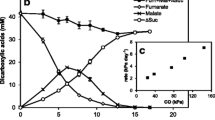Abstract
Kinetic studies of the uptake of 63Ni were undertaken with two strains of Alcaligenes eutrophus, known to require nickel ions for chemolithotrophic growth. Using carbon dioxide as sole carbon source, growth is stimulated by low concentrations of nickel with optimum concentration for growth stimulation at about 0.3 μM nickel. Higher nickel concentrations were inhibitory. Heterotrophic growth on fructose was not stimulated by nickel ions.-Upon transfer into phosphate buffer freed of heavy metal ions, autotrophically grown cells exhibited rapid uptake of 63Ni which was dependent upon th presence of hydrogen, oxygen and carbon dioxide. Within 60 min nickel was accumulated from the medium, reaching 280-fold concentration in the cells. The observed uptake exhibited a temperature optimum at about 29° C and was markedly inhibited by metabolic inhibitors such as arsenite, iodoacetate, methylene-blue, sodium azide and sodium cyanide. Other heavy metal ions (Zn, Co, Mn and Cu) only slightly inhibited 63Ni-uptake. The efflux of 63Ni from the cells was stimulated by 58NiCl2 and by toluene. These data indicate that nickel ions are accumulated by an energy dependent mechanism in chemolithotrophically grown cells of these strains.
Zusammenfassung
Die Kinetik der Aufnahme von 63Ni wurde an zwei Stämmen von Alcaligenes eutrophus untersucht, die Nickelionen für das chemolithotrophe Wachstum benötigen. Mit Kohlendioxid als einziger Kohlenstoffquelle wird das Wachstum durch niedrige Konzentrationen von Nickel gefördert, wobei das Optimum der Wachstumsförderung bei 0,3 μM Nickel lag. Höhere Nickelkonzentrationen wirkten hemmend. Das heterotrophe Wachstum mit Fructose wurde durch Nickelionen nicht gefördert. — Übertragen in Phosphatpuffer, der von Schwermetallionen befreit worden war, zeigten autotroph gewachsene Zellen eine rasche Aufnahme von 63Ni, sofern Wasserstoff, Sauerstoff und Kohlendioxid zugegen waren. Dabei wurde Nickel innerhalb von 60 min aus dem umgebenden Medium bis zur 280 fachen Konzentration in den Zellen angehäuft. Die beobachtete Ni-Aufnahme zeigte ein Temperaturoptimum bei etwa 29° C und wurde durch Hemmstoffe wie Arsenit, Jodacetat, Methylenblau, Natriumazid und Natriumcyanid stark beeinträchtigt. Andere Schwermetallionen (Zn, Co, Mn und Cu) verminderten die Nickelaufnahme nur geringfügig. Durch 58NiCl2 und Toluol wurde der Efflux von 63Ni aus den Zellen gefördert. Die Beobachtungen lassen darauf schließen, daß Nickelionen durch einen energieabhängigen Prozeß in chemolithotroph gewachsenen Zellen dieser Stämme angehäuft werden.
Similar content being viewed by others
Literatur
Bartha, R.: Physiologische Untersuchungen über den chemolithotrophen Stoffwechsel neu isolierter Hydrogenomonas-Stämme. Arch. Mikrobiol. 41, 313–350 (1962)
Bartha, R., Ordal, E. J.: Nickel-dependent chemolithotrophic growth of two Hydrogenomonas strains. J. Bact. 89, 1015–1019 (1965)
Bergmann, W.: Methoden zur Ermittlung mineralischer Bedürfnisse der Pflanzen. In. Handbuch der Pflanzenphysiologie (W. Ruhland, Hrsg.), Bd. 4, S. 37–89. Berlin-Göttingen-Heidelberg: Springer 1958
Bowien, B.: Hexoseabbau und Pentosebiosynthese in Hydrogenomonas. Dissertation, Univ. Göttingen (1970)
Bray, G. A.: A simple efficient liquid scintillator for counting aqueous solutions in a liquid scintillation counter. Analyt. Biochem. 1, 279–285 (1960)
Bucheder, F., Broda, E.: Energy-dependent zinc transport by Escherichia coli. Europ. J. Biochem 45, 555–559 (1974)
Cobet, A. B., Wirsen, C., Jones, G. E., The effect of nickel on a marine bacterium Arthrobacter marinus sp. nov. J. gen. Microbiol. 62, 159–169 (1970)
Conway, E. J., Downey, M.: An outer metabolic region of the yeast cell. Biochem. J. 47, 347–355 (1950)
Deutscher, M. P.: Preparation of cells permeable to macromolecules by treatment with toluene: Studies of transfer ribonucleic acid nucleotidyltransferase. J. Bact 118, 633–639 (1974)
Fuhrmann, G. F., Rothstein, A.: The transport of Z2+, Co2+ and Ni2+ into yeast cells. Biochim. biophys. Acta (Amst.) 163, 325–330 (1968)
Fuhrmann, G. F., Rothstein, A.: The mechanism of the partial inhibition of fermentation in yeast by nickel ions. Biochim. biophys. Acta (Amst.) 163, 331–338 (1968)
Gentry, C. H. R., Sherrington, L. G.: Extraction and photometric estimation of some metals with 8-hydroxyquinoline. Analyst 75, 17–21 (1950)
La Rivière, J. W. M.: On the microbial metabolism of the tartaric acid isomers. Dissertation. Univ. Delft (1958)
Nelson, D., Kennedy, E. P.: Magnesium transport in Escherichia coli. Inhibition by cobaltous ion. J. biol. Chem. 246, 3042–3049 (1971)
Nielsen, F. H., Ollerich, D. A.: Nickel: A new essential trace element. Fed. Proc. 33, 1767–1772 (1974)
Nomoto, S., McNeely, M. D., Sunderman, F. W.: Isolation of a nickel α-2-macroglobulin from rabbit serum. Biochemistry 10, 1647 (1971)
Reid, D. F., Frank, H. A.: Isotopic method for estimating microbial cell volumes. J. Bact. 92, 639–644 (1966)
Schlegel, H. G., Kaltwasser, H., Gottschalk, G.: Ein Submersverfahren zur Kultur wasserstoffoxidierender Bakterien: Wachstumsphysiologische Untersuchungen. Arch. Mikrobiol. 38, 209–222 (1961)
Schmidt, K. Jensen, S. L., Schlegel, H. G.: Die Carotinoide der Thiorhodaceae. I. Okenon als Hauptcarotinoid von Chromatium okenii Perty. Arch. Mikrobiol. 46, 117–126 (1963)
Skaar, H., Rystad, B., Jensen, A.: The uptake of 63Ni by the Diatom Phaeodactylum tricornutum. Physiol. Plant 32, 353–358 (1974)
Van Steveninck, J., Booij, H. L.: The role of polyphosphates in the transport mechanism of glucose in yeast cells. J. gen. Physiol. 48, 43–60 (1964)
Tabillion, R.: Energieabhängige Nickelaufnahme bei Alcaligenes eutrophus Stamm H 1 und H 16. Diplomarbeit, Univ. Saarbrücken (1976)
Weitzman, P. D. J.: Behaviour of enzymes at high concentration. Use of permeabilised cells in the study of enzyme activity and its regulation. FEBS Letters 32, 247–250 (1973)
Wilde, E.: Untersuchungen über Wachstum und Speicherstoffsynthese von Hydrogenomonas. Arch. Mikrobiol. 43, 109–137 (1962)
Winslow, C. E. A., Haywood, E. T.: The specific potency of certain cations with reference to their effect on bacterial viability. J. Bact. 22, 49–69 (1931)
Author information
Authors and Affiliations
Rights and permissions
About this article
Cite this article
Tabillion, R., Kaltwasser, H. Energieabhängige 63Ni-Aufnahme bei Alcaligenes eutrophus Stamm H 1 und H 16. Arch. Microbiol. 113, 145–151 (1977). https://doi.org/10.1007/BF00428595
Received:
Issue Date:
DOI: https://doi.org/10.1007/BF00428595




